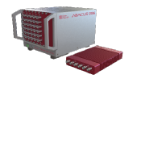Accelerometers
Accelerometers are electromechanical devices which measure the acceleration of moving and vibrating bodies. They contain capacitive plates, some of which are fixed and others attached to miniscule springs that move as forces act on the sensor. As the plates move, the capacitance changes and from these changes, the acceleration is determined. They can measure on one, two or three axes. There are a range of accelerometers some of which contain additional features. They utilise different ways of working. Apart from sensing changes in capacitance, they can use the piezoelectric effect which means tiny crystal structures output electrical charge when placed under mechanical stress. Accelerometers can have an analogue interface which is read by a microcontroller or a digital interface which is more functional and less susceptible to noise. Alternatively, it can be a pulse-width modulator (PWM). Accelerometers can help analyse problems in engines by vibration testing. They are also used in computers to protect hard drives from damage if they are dropped; they detect free fall and switch off the hard drive automatically. They also detect when mobile phones or tablets are moved from side to side and switch the screen from portrait to landscape. High gravity accelerometers are the standard way of detecting car crashes and deploying airbags.
-
Data Physics UK Ltd
View company profileThe Data Physics 900 Series Dynamic Signal Analyser combines signal analysis capabilities with a new distributed real-time signal processing engine to provide unrivalled dynamic testing capabilities. The 900 Series hardware is designed for demanding field applications, and with modular gigabit Ethernet architecture, the 900 Series can be expanded to over 1,000 channels for laboratory use.
-
AV Industrial Products Ltd
View company profileThe company is based in Leicester (central England) with easy access to all motorway networks. It was founded approximately 20 years ago with links with the anti-vibration mounting industry for over 40 years, so is well positioned to offer expert advice and specialist knowledge of all vibration control products and applications.
As well as offering an extremely wide range of standard products for next day delivery, We also offer custom made products in a wide range of elastomers including natural and synthetic rubber bonded to such materials as steel, stainless steel, aluminium and various plastics.
- Decades of experience
- Unbeatable Value
- High Quality product compliance
- Product testing - Physical and chemical material analysis
- Product design criteria


